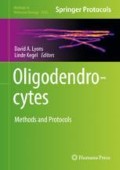Abstract
Genetic mouse models facilitate investigation of mechanisms underpinning human diseases and aid the development of novel therapeutic treatments. To better understand the demyelination and remyelination processes in adult-onset demyelinating diseases like multiple sclerosis (MS), we have developed the DTA mouse model system that allows for the widespread ablation of the mature oligodendrocytes, resulting in demyelination throughout the central nervous system (CNS). Induction of oligodendrocyte death in young adult DTA mice causes extensive CNS demyelination that leads to a severe neurological disease, followed by a full recovery that is associated with extensive replenishment of oligodendrocytes and remyelination. Thus, the DTA mouse enables investigation of the mechanisms that promote remyelination in MS and other adult-onset demyelinating diseases. Approximately 30 weeks later, the recovered DTA mice develop a fatal secondary demyelinating disease that is mediated by autoimmune T cells. Therefore, the DTA mouse model is also ideal for elucidating the role of oligodendrocyte death in eliciting autoimmunity in MS. In this chapter we describe the methods we used to generate the DTA mouse model and to analyze both the primary and secondary demyelinating diseases in DTA mice.
Access this chapter
Tax calculation will be finalised at checkout
Purchases are for personal use only
References
Nave KA, Trapp BD (2008) Axon-glial signaling and the glial support of axon function. Annu Rev Neurosci 31:535–561
Nave KA (2010) Myelination and the trophic support of long axons. Nat Rev Neurosci 11(4):275–283
Trapp BD, Nave KA (2008) Multiple sclerosis: an immune or neurodegenerative disorder? Annu Rev Neurosci 31:247–269
Franklin RJ, Ffrench-Constant C (2008) Remyelination in the CNS: from biology to therapy. Nat Rev Neurosci 9(11):839–855
Nakahara J, Aiso S, Suzuki N (2010) Autoimmune versus oligodendrogliopathy: the pathogenesis of multiple sclerosis. Arch Immunol Ther Exp 58(5):325–333
Barnett MH, Prineas JW (2004) Relapsing and remitting multiple sclerosis: pathology of the newly forming lesion. Ann Neurol 55(4):458–468
Stys PK, Zamponi GW, van Minnen J, Geurts JJ (2012) Will the real multiple sclerosis please stand up? Nat Rev Neurosci 13(7):507–514
Traka M, Arasi K, Avila RL, Podojil JR, Christakos A, Miller SD, Soliven B, Popko B (2010) A genetic mouse model of adult-onset, pervasive central nervous system demyelination with robust remyelination. Brain 133(10):3017–3029
Ivanova A, Signore M, Caro N, Greene ND, Copp AJ, Martinez-Barbera JP (2005) In vivo genetic ablation by Cre-mediated expression of diphtheria toxin fragment A. Genesis 43(3):129–135
Doerflinger NH, Macklin WB, Popko B (2003) Inducible site-specific recombination in myelinating cells. Genesis 35(1):63–72
Collier RJ (2001) Understanding the mode of action of diphtheria toxin: a perspective on progress during the 20th century. Toxicon 39(11):1793–1803
Maxwell IH, Maxwell F, Glode LM (1986) Regulated expression of a diphtheria toxin A-chain gene transfected into human cells: possible strategy for inducing cancer cell suicide. Cancer Res 46(9):4660–4664
Palmiter RD, Behringer RR, Quaife CJ, Maxwell F, Maxwell IH, Brinster RL (1987) Cell lineage ablation in transgenic mice by cell-specific expression of a toxin gene. Cell 50(3):435–443
Traka M, Podojil JR, McCarthy DP, Miller SD, Popko B (2016) Oligodendrocyte death results in immune-mediated CNS demyelination. Nat Neurosci 19(1):65–74
Bjartmar C, Wujek JR, Trapp BD (2003) Axonal loss in the pathology of MS: consequences for understanding the progressive phase of the disease. J Neurol Sci 206(2):165–171
Author information
Authors and Affiliations
Corresponding author
Editor information
Editors and Affiliations
Rights and permissions
Copyright information
© 2019 Springer Science+Business Media, LLC, part of Springer Nature
About this protocol
Cite this protocol
Traka, M. (2019). The DTA Mouse Model for Oligodendrocyte Ablation and CNS Demyelination. In: Lyons, D., Kegel, L. (eds) Oligodendrocytes. Methods in Molecular Biology, vol 1936. Humana Press, New York, NY. https://doi.org/10.1007/978-1-4939-9072-6_17
Download citation
DOI: https://doi.org/10.1007/978-1-4939-9072-6_17
Published:
Publisher Name: Humana Press, New York, NY
Print ISBN: 978-1-4939-9070-2
Online ISBN: 978-1-4939-9072-6
eBook Packages: Springer Protocols

